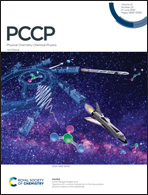The shuttling mechanism of foldaxanes: more than just translocation and rotation†
Abstract
Tailoring the structures of nanomachines to achieve specific functions is one of the major challenges in chemistry. Disentangling the different movements of nanomachines is critical to characterize their functions. Here, the motions within one kind of molecular machine, a foldaxane, composed of a foldamer with a spring-like conformation on an axle have been examined at the molecular level. With the aid of molecular dynamics simulations and enhanced sampling methods, the free-energy landscape characterizing the shuttling of the foldaxane has been drawn. The calculated free-energy barrier, amounting to 20.7 kcal mol−1, is in good agreement with experiments. Further analysis reveals that the predominant contribution to the free-energy barrier stems from the disruption of the hydrogen bonds between the foldamer and the thread. In the absence of hydrogen bonding interactions between the terminals of the foldamer and the thread, shrinkage and swelling movements of the foldamer have been identified and investigated in detail. By deciphering the intricate mechanism of how the foldaxane shuttles, our understanding of motions within molecular machines is expected to be improved, which will, in turn, assist the construction of molecular machines with specific functions.

- This article is part of the themed collection: 2020 PCCP HOT Articles


 Please wait while we load your content...
Please wait while we load your content...